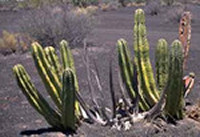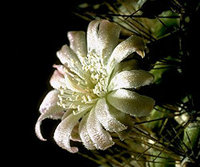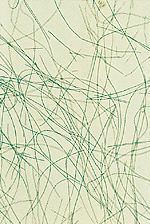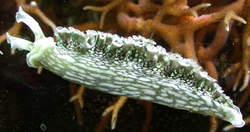|
Return
to Biology 1114 Index Page

Preview
Material for Exam 2 - Fall 2002
Print
the PDF version (no pictures, better printing) |
|
|
|
|
 source source |
|
|
|
|
|
|
|
|
|
|
|
|
|
|
|
|
|
|
|
|
|
In
the Sonoran Desert of Mexico, Dr. Ted Fleming recently made some observations
concerning the relationship between a species of moth (Senita moth) and
a cactus species (Senita cactus). The cactus blooms (flowers) during the
spring and summer only. At this time, successive generations of Senita moths
pollinate the cactus flowers as they move from flower to flower feeding
on the nectar contained in the flowers. They also lay their eggs on the
flower at this time. Once a flower is pollinated it will produce marble-sized
red fruit, some of which is eaten by the Senita moth larvae (hatched eggs).
These larvae will form pupae that hatch as adult moths. The larvae that
come from eggs late in the summer do not have time to pupate and mature
into adult moths because the cactus stops fruiting. Therefore they bore
into the cactus branches and wait for spring when the weather is warmer
and there is more food available. The Senita cactus blooms are open only
at night, when moths are active. When the weather starts to cool at the
end of summer, bees that feed early in the day may find flowers still open.
But in warmer weather, at the height of the blooming season, alas, all the
drinking establishments (i.e., flowers) close at dawn. Thus pollination
is totally dependent on the Senita moth. |
|
|
|
|
|
 source source |
|
|
|
|
|
|
|
|
|
|
|
|
|
|
|
|
|
|
|
|
|
|
|
|
|
 source source |
|
|
|
|
|
|
|
|
|
 source source |
|
|
|
|
|
|
|
|
|
|
|
|
|
|
|
|
|
In
1883, Thomas Englemann used a prism to project the full spectrum of visible
light along the length of a filamentous (resembles a strand of hair) green
alga (singular of algae) that contains chlorophyll a and b. This experimental
set-up exposed sections of the alga to different wavelengths of light (ranging
from violet through red). He then placed aerobic bacteria in the container
with the alga. These bacteria require oxygen and accumulated in the areas
with higher oxygen concentration. This allowed Englemann to determine which
sections of the alga were producing the most oxygen and thus which wavelengths
of light resulted in the highest rate of photosynthesis. |
|
|
|
|
|
|
|
|
|
|
|
|
|
|
|
|
|
|
|
|
|
|
|
|
|

source |
|
|
|
A scientist observes that about
95% of the individual grasshoppers of a particular species are green,
similar to the plants that they live on. He hypothesizes that these grasshoppers
are green because they are harder for visual predators to detect against
the green background of plants. To test this hypothesis, the scientist
conducts an experiment. He marks 100 green grasshoppers with spots of
red nail polish, another 100 green grasshoppers with transparent (colorless)
nail polish, and a third 100 green grasshoppers are left unmarked. Twenty-five
(25) of each type are placed in each of 4 field plots in different locations,
which are videotaped over the course of a day to document predation (without
the presence of the scientist to influence predator behavior). This whole
experiment is repeated on 3 days and the results compared. He predicts
that, if the hypothesis is correct, natural predators such as birds and
praying mantises (which are also green insects) will capture more of the
red-spotted grasshoppers than the control grasshoppers. He combines results
(below) for all 4 plots and 3 days, after determining that there were
no statistical differences between days or plots.
| Grasshopper
group |
Percent captured
by birds |
Percent captured
by praying mantises |
| Red nail polish |
42 |
14 |
| Transparent nail polish |
16 |
13 |
| Unmarked |
15 |
17 |
|
|
|
|
|
|
|
|

source |
|
|
|
|
|
|
|
|
|
|

source |
|
|
|
|
|
|
|
|
|
|
|
|
|
|
|
|
|
|
|
|
|
|
|
|
Sea
slugs (snails without shells) inhabit various marine (ocean) communities.
Their gills (gas-exchange organs) are fingerlike projections on their dorsal
side (back). Elysia spp. (sea slugs) live on well-lit coral reefs and eat
certain green seaweeds (algae). Rather than completely digesting the algae,
their digestive tract cells engulf (phagocytize) the chloroplasts and temporarily
store them intact and fully functional in their gills, while digesting the
rest of the algae. The sea slugs thus have a green color similar to the
algae they crawl over and eat. Similarly, many corals (primitive invertebrate
animals) contain symbiotic (living inside) intact single-celled algae, rather
than just their chloroplasts. Since it is possible for photosynthesis and
respiration to occur simultaneously, only the net release or consumption
of CO2 and O2 by the slug/chloroplasts or coral/algae pairs can be measured
easily. |
|
|
|
|
|
|
|
|
|
|
|
|
|
|
|

source |
|
|
|
|
|
|
|
|
|
|
|
|
|
|
Soapberry
bugs are found in the southern U.S. including Oklahoma. They feed only on plants
in the family Sapindaceae by inserting their piercing mouthparts into the fruits
and sucking the contents of the seeds. The lengths of the "beaks"
of these bugs reflect the size of the fruits on which they feed. Those populations
that feed on big fruits tend to have long beaks; those feeding on smaller fruits
have short beaks. Equally important, is the observation that soapberry bugs
mate and lay their eggs only on the fruit they eat. In the 1950's, horticulturalists
brought three new species of Sapindaceae plants into the U.S. and soapberry
bugs began to feed on them. Since the introduced plant species had much small
fruits than the native plant species, Scott Caroll and Christin Boyd studied
the changes that occurred in beak lengths of soapberry bugs. They found that
over time, those bugs living on the introduced plants (smaller fruits) had shorter
beaks than those living on native plants (larger fruits). |
|
|
|
|
|
|
|
|
|
|
|
|
|
|
|
|
|
|
|
 |
|
|
|
 |
|
|
|
|
|
 |
 |
 |
 |
 |
 |
 |
 |
 |
 |
 |
 |
 |
 |
 |
 |
 |
 |
 |
 |
 |
 |
 |
 |
 |
 |
 |
 |

 source
source source
source source
source source
source




